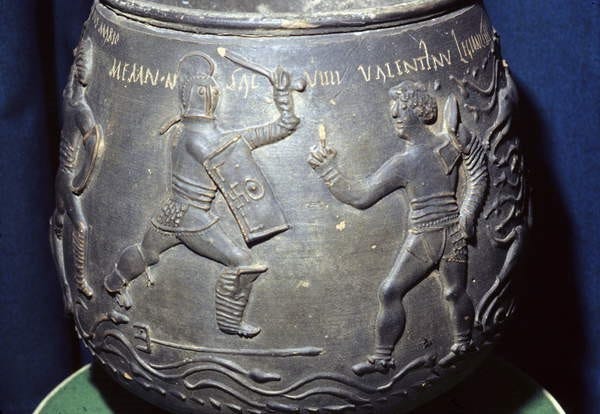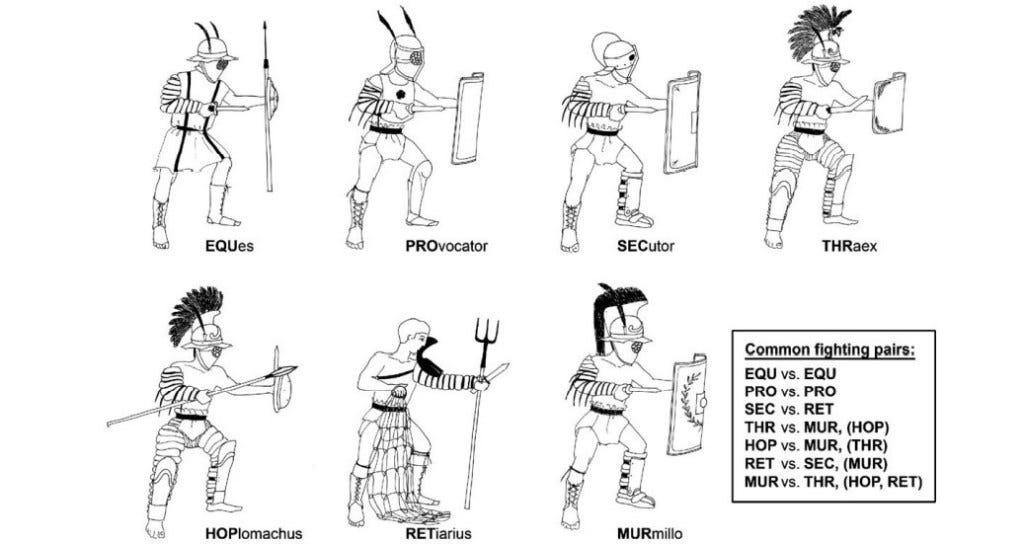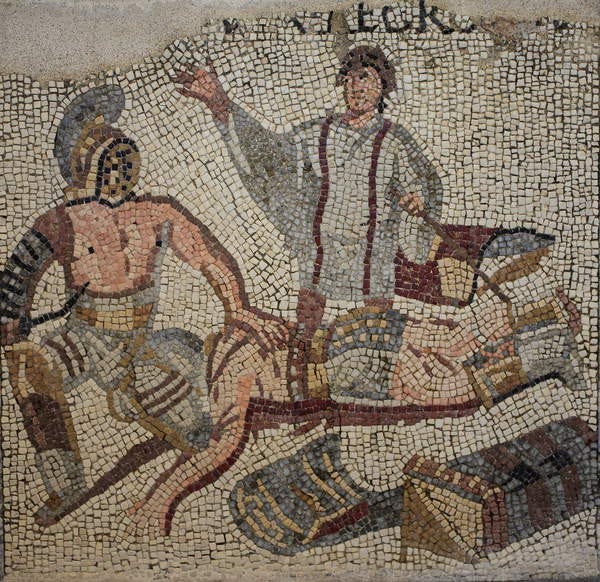Dear Classical Wisdom Reader,
Today we’re going back in time…
But maybe a little less time than usual.
With Gladiator 2 hitting cinemas, I thought it would be fun to revisit the original Russell Crowe film, which is astonishingly now twenty-four years old.
Yet just how accurate is the Roman world created by director Ridley Scott?
Today we’re focusing in on the depiction of combat in the arena, and looking at the historical truth of gladiator fights. Unlike what you see in the movies, real gladiator battles often had referees… and strict sets of rules.
Read on below to discover the often surprising truth of gladiators, and what Hollywood gets wrong.
Though if the world of swords and spectacle isn’t your thing, we’ve got something much more philosophical for you today as well…
Our live event Why Socrates Matters will look at the life and legacy of one of history’s most famed philosophers.
Anya will be joined by a line-up of prominent professors and acclaimed authors to discuss Socrates’ teachings, and their relevance to our lives today.
That’s TODAY at NOON EST. If you can’t make it live, register ahead of time and you will be sent a recording of the event.
Philosophy and gladiator fights… The Classics really do have something for everyone!
All the best,
Sean Kelly
Managing Editor
Classical Wisdom
Gladiator Combat: Historical Fact or Hollywood Fiction?
By Kevin Blood
When we watch the trials of the fictional Roman General Maximus in Ridley Scott’s Oscar-winning film Gladiator, the arena fights that we see make for vivid, nail-biting spectacle, but how close to the truth is Scott’s depiction of professional gladiatorial combat? Films like Gladiator become part of our cultural memory, and inaccuracies contained within them can come to represent a kind of truth, if left unchallenged.
Scott creates a compelling picture of ancient Rome; what we see appears authentic. We meet Marcus Aurelius, scribbling in his tent, perhaps working on his Meditations, near Carnuntum. We see his ‘mad’ son Commodus, glowering at senators and cavorting in the arena. We meet the fictional General Maximus, whose qualities are reminiscent of the Claudius Maximus described by Marcus Aurelius. Scott’s film taps in to our ‘cultural memory’ of the Roman world, creating a seemingly authentic vision of it. Yet Scott’s aim was not primarily authenticity, but rather to create a compelling film. In the fight sequences, we are shown professional gladiatorial combat of the imperial era that has a sheen of authenticity. This depiction, however, is not consistent with what we know about professional gladiatorial combat in the imperial era.
But first, who were professional gladiators? By the imperial period they were: slaves, kidnap victims, prisoners of war, criminals, or free people, sometimes ex-gladiators who took a sacred oath to train, suffer and fight until killed or released. They had the chance of freedom, profit and fame. They trained at a gladiator school (ludus), were subject to military discipline and expert tuition, and they fought humans of comparable skill in rule-bound spectacles. This happened under the auspices of a lanista, who leased gladiators to an editor. The lanista was compensated for their full cost if they died in the arena.
When we explore the observable material culture and interpretations of the ancient literary sources, we see professional gladiatorial combat in the imperial era had strict rules and norms, known as leges pugnandi (fighting/fight rules), which helped to preserve the lives of skilled and popular gladiators. These leges pugnandi provide a clear contrast to the spectacle of rule-free, to-the-death combat in Scott’s film.
Before the imperial era, gladiatorial combat was to-the-death. By the time of the empire, however, professional gladiators fought two or three bouts per year; epigraphic evidence shows the average age at death was between 22 and 27 years old. Their chances of survival has been estimated to be 8 out of 10 fights during the A.D. 1st century, to 5 out of 10 fights between the A.D. 2nd and 3rd centuries. These rising numbers appear to contradict the idea that the existence of leges pugnandi had a preservative effect. Nevertheless, this was the case for skilled, trained, and popular gladiators.
Suetonius tells us that the first emperor, Augustus, banned gladiatorial contests where the defeated fighter was forbidden to plead for mercy. Augustus, an editor of arena games, was no humanitarian; his concern was the high cost of hiring professional gladiators. A senatus consultum about the time of Marcus Aurelius and Commodus sought to lower and control the prices of trained gladiators, whose price ranged from as low as 3000 sesterces to as much as 12,000 or 15,000 sesterces. Deaths of high-ranking gladiators increased the costs of public games. The records of gladiators from Pompey shows that high-ranking gladiators could have long careers. This suggests that they were spared for more prestigious fights. Clearly, money was a factor in the evolution of the leges pugnandi, as more frequent games became standard fare. This standard fare was supplemented with lavish events, like celebrations for the emperor’s birthday or a military triumph. The economics of the games were a serious concern, yet in Scott’s film Commodus, carelessly funds expensive games. The combat depicted in the film, like the emperor, is also unrestrained.
Mosaics from the period show restraint was in fact encouraged by two referees, who monitored strict combat rules; mosaics and ceramic vases show gladiators in a gesture of surrender, with finger raised and shield lowered. This suggests they had an expectation of cessation and mercy. Typically fighting was conducted by pairs recruited from seven different gladiator types. Opponents wielded evenly balanced weapons for attack and defense.
A good display was desirable. To make combat fair, opponents of comparable strength and skill were matched. They fought to a decisive outcome: defeat through death, as a result of incapacitation, or defeat due to exhaustion. A draw typically meant both opponents were permitted to live. The superiority of one fighter had to be shown to allow the public to reach a decision. The loser’s fate ultimately rested with the editor, who appealed to the mood of the crowd. With the cry of iugula (lance him through), the defeated were expected to submit to the death thrust. Not a bloodless spectacle, but it does not appear to have been as bloodthirsty as Scott’s film suggests.
Scott’s combat is as a free-for-all, no rules, no referees; each fight is to the death, with one exception. When Maximus fights Titus of Gaul, he downs Titus and then grants mercy, thus usurping the editor’s (Commodus’) prerogative. Titus is announced as the only undefeated champion in Roman history, returning to the arena after five years in retirement (meaning he has gained his freedom through displays of courage and excellence in the arena); his age and the enthusiastic and positive crowd reaction suggest his popularity and a long career. The crowd, however, quickly turn and scream for his death when he is defeated, even though he displayed courage, fighting skills and a willingness to die. In Scott’s arena, the odds of Titus having a long career and making retirement stretch credulity. In clear contrast to Scott’s portrayal of rule-free professional gladiatorial combat, classical scholars and archaeologists show a more restrained (yet still bloody) spectacle was the norm.
If we join the fragments of our mosaics with ancient inscriptions we see a clearer picture of combat with leges pugnandi. Leges pugnandi had a coherent logic, with the purposes of producing fair and aggressive combat between well-matched fighters, and the limitation and/or reduction of fatalities. Fights to the death were exceptional and even required imperial permission. An uncommon inscription from Beroia in Macedonia required gladiators to fight “for their lives”; however, the organizer had to get an imperial indulgentia (indulgence).
Clearly the audiences of the imperial era were knowledgeable, with very stringent standards for gladiatorial performance. Fans, aficionados, and editores wanted to preserve high-ranking, skilled gladiators. They were few and expensive, and they put on a better show. Each fight they survived increased their value, and they were spared for big-ticket events. Good matches between evenly matched opponents were desirable. Popular pairings of high-ranked gladiators who drew a big crowd made for good spectacle. Low-ranking or less skilled gladiators were more expendable, the odds stacked against them as they battled their way to a higher-ranking. Professional gladiatorial combat in the imperial era was an ordered affair, but not a bloodless one; because of the existence of leges pugnandi, the rise in deaths in the imperial era, despite the preservative elements, are explained by a coherent systemic logic.
The importance of leges pugnandi is also supported by physical evidence. Bone fragments studied with osteo-archaeology from a cemetery site for gladiators at Ephesus, analysed by Fabian Kanz and Karl Grossschmidt, offer a clear view of how injured, dying and dead gladiators of the imperial era were treated. When seriously injured during training or combat, they received medical treatment, surgical intervention, or wound cleaning. They were then granted sufficient time to heal and recover.
The wounds suffered by these gladiators are consistent with weaponry commonly used in the arena and in training scenarios. The skull wounds are singular in nature, supporting the notion of leges pugnandi by which fight officials intervened when a fight winning blow was struck. Some killing wounds are rounded in profile and the authors suggest these might have been delivered by a rounded hammer, carried by an arena assistant dressed as Charun, who dispatched mortally wounded fighters. This evidence provides a contrast to Scott’s film, wherein no leges pugnandi are apparent. Kanz and Grossschmidt show a form of rule-bound combat, as described by the historic sources, is confirmed due to the absence of multiple perimortem traumatized individuals. These bones do not display the excessive violence often observed on, for instance, much later medieval battleground victims.
Despite inaccuracies, Gladiator has immense value. Scott’s film and popular productions like it play a big role in sparking interest in ancient cultures. Their use as a comparison can help clarify our understanding of the ancient world by prompting inquiry; they encourage research, speculation and debate. They expose the world of the Classics to future generations who might be inspired by what they see to undertake a course of scholarship. Through analyzing both the artistic and scholarly worlds, fresher, clearer, and more coherent perspectives of the past can come in to view.









Thanks
Had to watch Gladiator tonight for the spectacle in advance of the new movie.
Ridley is always entertaining.
Just like Comodus!!
Hail Caesar! We who are about to die salute thee.